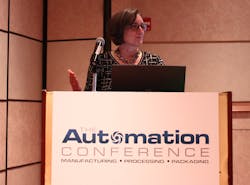General Motors Touts Cooperation of Manufacturing and Engineering
With about 10,000 employees at 165 facilities in more than 30 countries, General Motors has incentive to standardize its operations globally. Whether it’s designing and building a car in Ohio or Texas, Korea or Brazil, GM adheres to its Global Manufacturing System for consistent requirements in the way that equipment, controls, processes and more work.
And throughout this system of global standards, it’s vital that manufacturing and engineering cooperate in close communication, notes Lee Visci, director of advanced vehicle development at GM. “Something that General Motors really does a good job of is bringing manufacturing and engineering together,” Visci said during her keynote that kicked off The Automation Conference 2014 in Chicago today.
Visci credits Mary Barra, who was made GM’s CEO earlier this year, with keeping that cooperative vision front and center. “Mary demands that manufacturing and engineering work together as one unit,” Visci said, explaining that the executive chief engineer makes the ultimate product decision, “but with a manufacturing chief engineer attached to his hip.” At vehicle launch, manufacturing takes the lead, but with an engineering partner.
There are key components to a good design and manufacturing balance, Visci described, including early engagement, frequent communication and interaction, collaboration, getting the manufacturing footprint determined upfront, determining processes early, packaging requirements, integration, and virtual analysis integrated with the reality of physical builds.
As a proponent of lean manufacturing, Visci also spoke of the need to eliminate or reduce the seven forms of waste: correction, over production, motion, material movement, waiting, inventory and processing. “The key to eliminating waste is to identify it,” she said.
Visci spoke of engineered waste. “A stroke of a pen across paper can cost or save millions of dollars in capital and operating cost,” she said. “You cannot leave lean thinking and waste elimination to the continuous improvement processing during or after launch.” GM locks in a long-term baseline of performance, whether good or bad, for the powertrain facility and its operations team, she added.
About the Author
Aaron Hand
Editor-in-Chief, ProFood World

Leaders relevant to this article:
